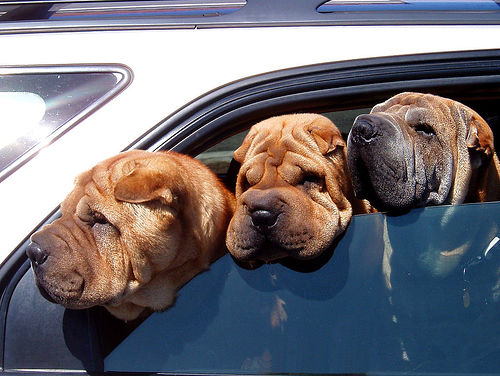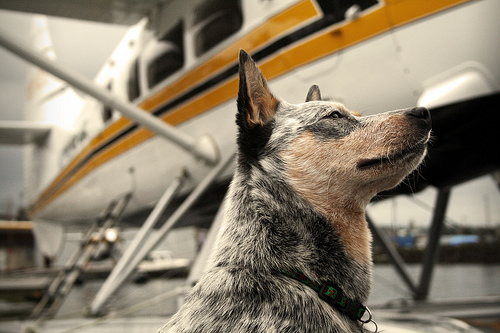Whether you’re taking your pet to the vet, down to the beach, on vacation, or just for a drive, it is essential to ensure that your pet has a safe and comfortable journey.
Traveling by Car

Every year animals are injured while traveling in cars. There are few guidelines that you should follow to ensure that your pet has a safe and pleasant experience when traveling in your car.
1. Always keep the safety of the driver and the animal in mind. Animals should not ride in the front seat where they can potentially create a distraction or interfere with your ability to drive. Also, in the event of an accident, the deployment of airbags can cause serious injury or even death to a pet in the front seat.
2. Small dogs, cats, and small mammals (e.g. rabbits, guinea pigs, etc.) should always be restrained in a pet carrier. Not only will your pet feel more secure and less stressed inside a carrier, but it can also prevent injuries caused by being thrown about inside the car.
3. If your dog is too large to fit comfortably inside a pet carrier, it should be safely restrained in the back seat. There are special harnesses or seatbelts that are available to guarantee that your dog stays in its assigned seat.
4. Dogs that are traveling in the back of pickup trucks should ideally be kept securely in a carrier, or at the very least, suitably restrained so as to prevent them from jumping out of the moving vehicle.
5. Although many dogs seem to find riding with their head out the window an exhilarating and pleasant experience, it is recommended that you do not let your dog do this. Dogs can suffer eye injuries from flying debris and ear injuries from their long ears flopping in the wind. Plus, if the window is fully down, unrestrained animals can jump out of the moving vehicle and do serious harm to themselves.
6. Always keep your car cool and well-ventilated, especially in summer. Pets are already excited and stressed when riding in a car – if the car is hot and stuffy, they can quickly hyperventilate or overheat. Pets should never be left in parked cars on warm days or extremely cold days. Cracking the window open an inch or two may not be sufficient to prevent hyperthermia and death. Also, never smoke while your pet is traveling in the car with you. Cigarette smoke is irritating to the eyes, nose, and lungs of animals, and has even been linked to cancer in cats.
7. If you are traveling long distances, remember to give your pet frequent opportunities to relieve itself. For cats, simply placing an absorbent towel in the bottom of its carrier may be adequate, as many cats are unwilling to use a litter box inside a car. Dogs should be let out of the car every couple of hours to urinate or defecate, as well as to get some exercise – always keep your dog on a leash, as they can easily run out into traffic.
8. Carry a bottle of water and a water dish for long journeys. Crushed ice can also be offered to thirsty pets.
9. For pets that suffer from car sickness, feeding them a small treat about 30 minutes before you leave can sometimes be helpful as empty stomachs contribute to the feeling of car sickness. If this is ineffective in preventing car sickness, consult your veterinarian about a prescribing a medication, such as antihistamines, that will help your pet cope with travel.
10. Some pets are incredibly stressed out and terrified of riding in a car. These animals may require behavioral modification to remedy their fear. Practice putting your animal in the car but not driving anywhere. Praise your pet and offer it treats, so that it feels comfortable just sitting in the car. Repeat this many times. As your pet’s confidence grows, try taking it for small trips, then increasingly longer journeys. Some pets will gradually overcome their fear of the car. For unresponsive pets, it may be necessary to obtain a tranquilizer from the veterinarian as a last resort.
11. For long journeys/vacations, there are few items you should not leave home without. It is good to have a copy of your pet’s vaccination record and a current health certificate, especially if your pet is taken ill. Your pet should have a collar with identification tags, or better yet, a microchip, in case it gets lost. Leashes, grooming combs or brushes, and pet food are a few other essentials to bring with you.
12. If you are taking your pet on vacation, always call ahead to check that any accommodation you are staying in allows pets.
13. Remember, while taking a pet on vacation may seem like a fun idea, it is not always in your pet’s best interest. Traveling can be extremely stressful for some animals, and can expose them to new parasites and diseases. Consider keeping your animal in a kennel, or finding a pet sitter while you are away.
Traveling by Air

Taking a pet on a trip by airplane is a big undertaking. Always plan far in advance and consult with your veterinarian before you consider traveling by air with your pet. Here are few tips for making the process run smoothly:
1. If you are traveling internationally, ask your veterinarian about any requirements for taking your pet into the country of your destination. Your pet may need vaccinations, health certificates, a microchip, quarantine, etc.
2. Your pet should also be examined by a veterinarian for any medical conditions that may prevent it from flying (e.g. heart disease).
3. Check with your airline about its rules and requirements for pets.
4. Make sure your pet carrier is large enough to comfortably hold your pet and a water dish, and that it meets any safety requirements of the airline. If you do not own an adequate carrier, many airlines provide pet carriers for rent.
5. Line the pet carrier with thick blankets or towels. Provide your pet with its favorite toy to keep it occupied. And never forget to provide a bowl of water for the flight. The carrier should be appropriately labeled with your name and contact details, as well as a sticker that says “Live Animal”.
6. Book early morning or evening flights during the summer months, and midday flights during the winter to avoid extremes of temperature in the cargo hold.
7. Direct (nonstop) flights are preferable to changing planes, as they reduce the possibility of your pet becoming “lost luggage”.
8. Avoid feeding your pet within 6 hours prior to the plan trip – this may lead to travel sickness.
9. As mentioned above, always call ahead to ensure that the accommodation you are staying in accepts pets.
10. Remember, that when you take your pet to another country, you are exposing it to exotic, potentially life-threatening diseases. Sometimes it is better to leave your pet in a kennel or to hire a pet sitter.
(top photo: emdot)
(bottom photo: michaelwhays)